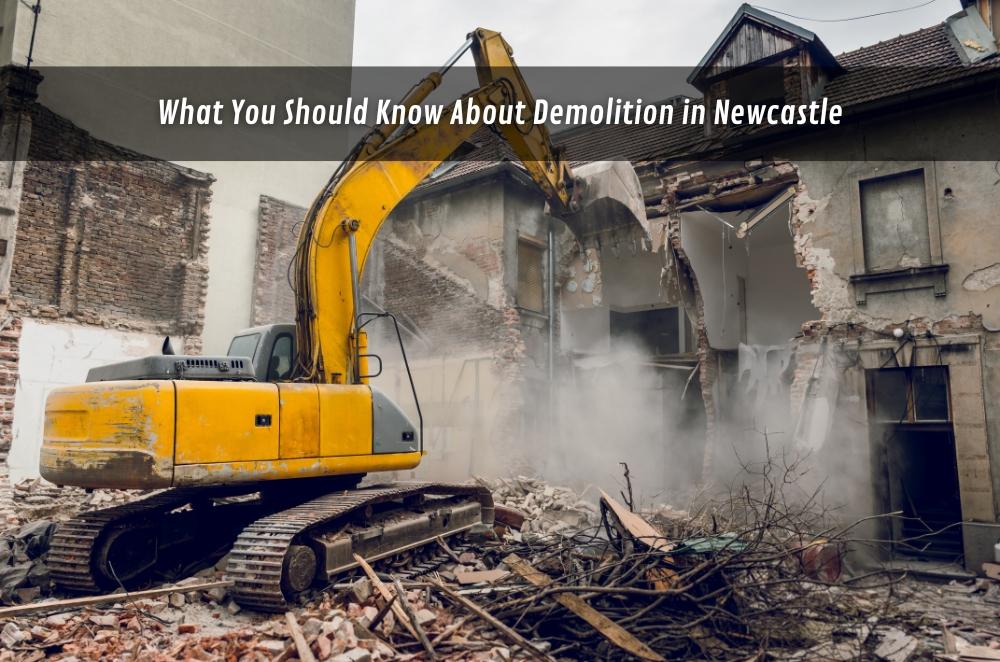What You Should Know About Demolition in Newcastle

When people picture demolition, they often imagine a dramatic teardown — machines ripping through timber and concrete, dust clouds rising, and the ground cleared in hours. But the real work starts well before any of that. Whether you're preparing for a knockdown-rebuild or clearing space for a new development, it’s the planning, compliance, and timing that shape how smoothly everything goes.
From heritage overlays to neighbour notifications, every detail matters — especially in regions like Newcastle, where older properties often come with quirks. Having been involved in a few projects myself, I've seen how assumptions can cost time and create unnecessary stress.
That’s why understanding how demolition Newcastle offers can make a huge difference. When you know what to expect — and what to avoid — the whole process becomes far less overwhelming and a lot more manageable.
Permits, plans and practical stuff no one tells you about
You can’t get far without sorting out the red tape. Sure, some small internal jobs might fly under the radar, but for anything involving full structure removal, you’ll need proper authorisation. This usually means either a complying development certificate (CDC) or going through a full development application (DA).
Depending on the site, there might be more:
-
Trees protected under local environmental plans
-
Adjoining fences and access points that affect neighbours
-
Requirements for erosion control if the land is sloped
-
Traffic control if plant machinery blocks public pathways
On one job in New Lambton, the crew was all ready to go, then found out no one had mapped the utility lines. The whole thing got pushed back while they waited on Dial Before You Dig and council clarification.
That’s the reality with demolition. Even if the job looks small, the rules are usually not.
Site safety isn’t optional — it’s a legal standard
Working with demolition sites involves more than just hard hats and temporary fencing. Safety protocols are embedded in law, especially where high-risk materials or machinery are in play. Contractors operating in NSW are expected to uphold specific standards that apply across all construction sectors.
A big part of this is aligning with demolition safety guidelines NSW, which outline how sites must be prepared, monitored and secured during all phases of work.
These requirements cover everything from structural assessments to dust and noise control, and they’re enforced for a reason. A neighbour of mine once had an old fibro shed taken down without proper risk checks, and the fallout was a serious headache involving asbestos testing and cleanup.
What happens after the structure is gone?
The building’s down. Great. Now what?
This is the part that always catches people off guard — the pile of bricks, dirt, nails, and splinters that needs to go somewhere. Even on tidy sites, demolition debris adds up fast. If you haven’t factored in how to deal with the waste, you’ll end up with delays, extra costs, and a headache trying to get it sorted midstream.
I’ve seen it done well, though. One builder I worked with in Cardiff had a tight system — skips lined up, materials sorted, no cross-contamination. The crew moved like clockwork. Kept the neighbours happy too.
A few key things to consider:
-
Plan for at least 2–3 skip bins for sorting different material types
-
Ask your contractor if they partner with recycling facilities
-
Check if your local area offers drop-off for certain types of waste
-
Don’t forget about soil or rubble that might not be accepted by standard waste providers
There’s value in bringing building waste management tips into conversations with your demolition contractor early on. It avoids trouble later and shows your builder you’ve thought this through.
Excavation and contractor coordination matter more than you think
There’s this moment on every site — after the dust clears and before the rebuild starts — where things can either stall or shift into high gear. Excavation often falls into that grey zone. It’s not a demo, but it’s also not construction yet. The site still feels raw. That’s why it’s crucial to make sure whoever’s handling the excavation is looped in from the get-go.
Sometimes you’ll find a team that does both demo and excavation. That’s fine, as long as both arms of the business talk to each other. I’ve seen teams turn up with different info, different scopes, and different expectations. Delays follow. Miscommunication kills momentum.
It helps to know the kind of traits that make an excavation crew reliable. That’s where thinking about choosing excavation contractors becomes useful. Even though the region differs slightly, the expectations around professionalism and coordination still apply.
What tends to stand out:
-
Crews that show up when they say they will
-
Operators who don’t just rely on GPS but actually understand site levels
-
Teams who leave the site prepped for whatever’s next, not just dug and dumped
-
Contractors who flag issues early instead of covering them up
And let’s be honest — on a messy site with overlapping trades, that stuff matters more than flashy branding or the number of machines on hand.
Communication is the best demolition tool you’ll never see
You won’t find it on a checklist or mentioned in most quotes, but communication is what separates smooth demolitions from the ones that stall halfway through. Whether it’s explaining a delay, flagging an issue with neighbouring fences, or just being upfront about timeframes, good teams keep you in the loop.
I worked on a project in Mayfield where the site manager actually took five minutes each morning to run through what was happening that day. Nothing fancy. But those five minutes saved everyone time. Trades knew where to go. The property owner wasn’t left guessing.
You don’t have to demand daily updates, but asking early on how the contractor communicates — and how often — gives you a sense of how things will go once the job starts.
Final thoughts: take the time to plan it properly
There’s no shortcut when it comes to safe, efficient demolition. The quieter parts — paperwork, contractor vetting, neighbour notifications — are just as important as the noisy ones. And if you’re doing this for the first time, take it from someone who’s watched projects go sideways due to small oversights: don’t leave things to chance.
Whether you’re removing a single dwelling or clearing a commercial block, each demolition project is its own puzzle. With the right process, the right team, and a bit of local insight, you can get it done cleanly — and move on to whatever comes next.








